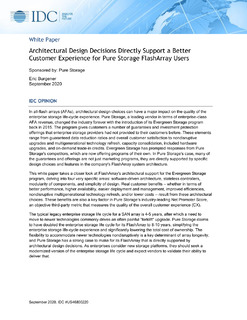In all-flash arrays (AFAs), architectural design choices can have a major impact on the quality of the enterprise storage life-cycle experience. Pure Storage, a leading vendor in terms of enterprise-class AFA revenue, changed the industry forever with the introduction of its Evergreen Storage program back in 2015. The program gives customers a number of guarantees and investment protection offerings that enterprise storage providers had not provided to their customers before. These elements range from guaranteed data reduction ratios and overall customer satisfaction to nondisruptive upgrades and multigenerational technology refresh, capacity consolidation, included hardware upgrades, and on-demand trade-in credits. Evergreen Storage has prompted responses from Pure Storage's competitors, which are now offering programs of their own. In Pure Storage's case, many of the guarantees and offerings are not just marketing programs, they are directly supported by specific design choices and features in the company's FlashArray system architecture.
This white paper takes a closer look at FlashArray's architectural support for the Evergreen Storage program, delving into four very specific areas: software-driven architecture, stateless controllers, modularity of components, and simplicity of design. Real customer benefits — whether in terms of better performance, higher availability, easier deployment and management, improved efficiencies, nondisruptive multigenerational technology refresh, and/or lower costs — result from these architectural choices. These benefits are also a key factor in Pure Storage's industry-leading Net Promoter Score, an objective third-party metric that measures the quality of the overall customer experience (CX).
The typical legacy enterprise storage life cycle for a SAN array is 4–5 years, after which a need to move to newer technologies commonly drives an often painful “forklift” upgrade. Pure Storage claims to have doubled the enterprise storage life cycle for its FlashArray to 8–10 years, simplifying the enterprise storage life-cycle experience and significantly lowering the total cost of ownership. The flexibility to accommodate newer technologies nondisruptively is a key determinant of array longevity, and Pure Storage has a strong case to make for its FlashArray that is directly supported by architectural design decisions. As enterprises consider new storage platforms, they should seek a modernized version of the enterprise storage life cycle and expect vendors to validate their ability to deliver that.


